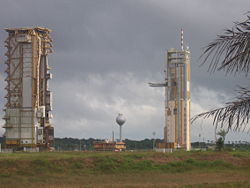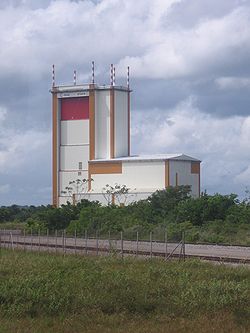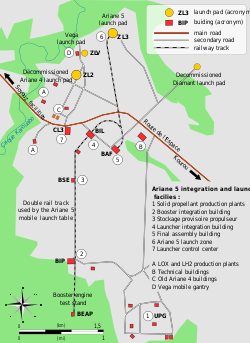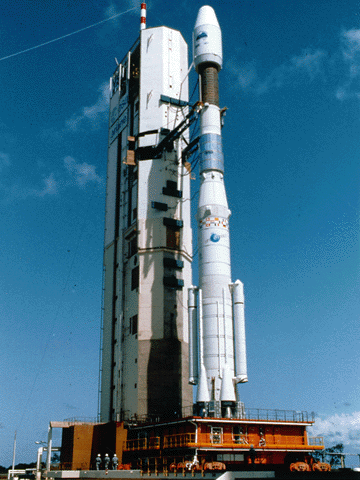
Centre Spatial Guyanais
Encyclopedia

France
The French Republic , The French Republic , The French Republic , (commonly known as France , is a unitary semi-presidential republic in Western Europe with several overseas territories and islands located on other continents and in the Indian, Pacific, and Atlantic oceans. Metropolitan France...
spaceport
Spaceport
A spaceport or cosmodrome is a site for launching spacecraft, by analogy with seaport for ships or airport for aircraft. The word spaceport, and even more so cosmodrome, has traditionally been used for sites capable of launching spacecraft into orbit around Earth or on interplanetary trajectories...
near Kourou
Kourou
Kourou is a commune in French Guiana, an overseas region and department of France located in South America.Kourou is the location of the Guiana Space Centre, France and ESA's main spaceport.-Geography:...
in French Guiana
French Guiana
French Guiana is an overseas region of France, consisting of a single overseas department located on the northern Atlantic coast of South America. It has borders with two nations, Brazil to the east and south, and Suriname to the west...
. Operational since 1968, it is particularly suitable as a location for a spaceport due to its proximity to the equator
Equator
An equator is the intersection of a sphere's surface with the plane perpendicular to the sphere's axis of rotation and containing the sphere's center of mass....
, and that launches are in a favourable direction over water. The European Space Agency
European Space Agency
The European Space Agency , established in 1975, is an intergovernmental organisation dedicated to the exploration of space, currently with 18 member states...
, the French space agency CNES
CNES
The is the French government space agency . Established under President Charles de Gaulle in 1961, its headquarters are located in central Paris and it is under the supervision of the French Ministries of Defence and Research...
, and the commercial Arianespace
Arianespace
Arianespace SA is a French company founded in 1980 as the world's first commercial space transportation company. It undertakes the production, operation, and marketing of the Ariane 5 rocket launcher as part of the Ariane programme....
company conduct launches from Kourou.
The location was selected in 1964 to become the spaceport
Spaceport
A spaceport or cosmodrome is a site for launching spacecraft, by analogy with seaport for ships or airport for aircraft. The word spaceport, and even more so cosmodrome, has traditionally been used for sites capable of launching spacecraft into orbit around Earth or on interplanetary trajectories...
of France
France
The French Republic , The French Republic , The French Republic , (commonly known as France , is a unitary semi-presidential republic in Western Europe with several overseas territories and islands located on other continents and in the Indian, Pacific, and Atlantic oceans. Metropolitan France...
. When the European Space Agency
European Space Agency
The European Space Agency , established in 1975, is an intergovernmental organisation dedicated to the exploration of space, currently with 18 member states...
(ESA) was founded in 1975, France offered to share Kourou with ESA. Commercial launches are bought also by non-European companies. ESA pays two thirds of the spaceport's annual budget, and has also financed the upgrades made during the development of the Ariane launchers.
Facilities



The ground facilities at Guiana Space Centre (GSC) include launcher and satellite preparation buildings, launch operation facilities and a solid propellant factory. The GSC facility covers a total of 850 square kilometres (328.2 sq mi).
The near-equatorial launch location provides an advantage for launches to low-inclination (or geostationary) Earth orbit
Geocentric orbit
A geocentric orbit involves any object orbiting the Earth, such as the Moon or artificial satellites. Currently there are approximately 2,465 artificial satellites orbiting the Earth and 6,216 pieces of space debris as tracked by the Goddard Space Flight Center...
s compared to launches from spaceport
Spaceport
A spaceport or cosmodrome is a site for launching spacecraft, by analogy with seaport for ships or airport for aircraft. The word spaceport, and even more so cosmodrome, has traditionally been used for sites capable of launching spacecraft into orbit around Earth or on interplanetary trajectories...
s at higher latitude. For example, the eastward boost provided by the Earth's rotation is about 1035 miles per hour (462.7 m/s) at the Guiana Space Centre versus about 908 miles per hour (405.9 m/s) at the United States
United States
The United States of America is a federal constitutional republic comprising fifty states and a federal district...
east coast Cape Canaveral
Cape Canaveral Air Force Station
Cape Canaveral Air Force Station is an installation of the United States Air Force Space Command's 45th Space Wing, headquartered at nearby Patrick Air Force Base. Located on Cape Canaveral in the state of Florida, CCAFS is the primary launch head of America's Eastern Range with four launch pads...
and Kennedy Space Center
Kennedy Space Center
The John F. Kennedy Space Center is the NASA installation that has been the launch site for every United States human space flight since 1968. Although such flights are currently on hiatus, KSC continues to manage and operate unmanned rocket launch facilities for America's civilian space program...
spaceports which are at 28°27′N latitude in Florida
Florida
Florida is a state in the southeastern United States, located on the nation's Atlantic and Gulf coasts. It is bordered to the west by the Gulf of Mexico, to the north by Alabama and Georgia and to the east by the Atlantic Ocean. With a population of 18,801,310 as measured by the 2010 census, it...
.
ELV (CECLES/ELA-1)
Originally built in the 1960s under the name of CECLES , the ELV pad located at 5.236°N 52.775°W was designed for the Europa-II rocket. One Europa-II was launched from the site, before the programme was cancelled.The pad was demolished, and subsequently rebuilt as the first launch complex for Ariane rockets. Renamed ELA (later redesignated ELA 1), it was used for Ariane 1
Ariane 1
Ariane 1 is the first version of the Ariane launcher family. Ariane 1 was designed primarily to put two telecommunications satellites at a time into orbit, thus reducing costs. As the size of the satellites grew Ariane 1 gave way to the more powerful Ariane 2 and Ariane 3 launchers.- Vehicle...
and Ariane 2 and 3 launches until being retired in 1989.
As of 2008, ELV-1 is being rebuilt to support launches of the Vega
Vega (launcher)
Vega is an expendable launch system being developed for Arianespace jointly by the Italian Space Agency and the European Space Agency. Development began in 1998 and the first launch, which will take place from the Guiana Space Centre, is planned for early 2012...
rocket, back under the current designation of ELV.
ELA 2
The ELA 2 pad , located at 5.232°N 52.776°W had been used for Ariane 4Ariane 4
Ariane 4 was an expendable launch system, designed by the Centre National d'Etudes Spatiales and manufactured and marketed by its subsidiary Arianespace. Ariane 4 was justly known as the ‘workhorse’ of the Ariane family. Since its first flight on 15 June 1988 until the last, on 15 February 2003, it...
launches until 2003.
ELA 3
As of 2008, ELA 3 , located at 5.239°N 52.768°W, is currently active for Ariane 5Ariane 5
Ariane 5 is, as a part of Ariane rocket family, an expendable launch system used to deliver payloads into geostationary transfer orbit or low Earth orbit . Ariane 5 rockets are manufactured under the authority of the European Space Agency and the Centre National d'Etudes Spatiales...
launches. These facilities cover an area of 21 square kilometres (8.1 sq mi).
ELS / Soyuz at CSG
ESA has built ELS at 5.305°N 52.834°W for launching RussiaRussia
Russia or , officially known as both Russia and the Russian Federation , is a country in northern Eurasia. It is a federal semi-presidential republic, comprising 83 federal subjects...
n-built Soyuz-2 rockets. The first Soyuz launch from ELS was postponed several times, but launched on October 21st 2011.
ELS is located on the territory of Sinnamary
Sinnamary
Sinnamary is a town and commune on the coast of French Guiana, between Kourou and Iracoubo. Sinnamary was the second French settlement to be founded in French Guiana: the town was founded in 1664....
commune, 27 km (16.8 mi) from Kourou harbor. It is 10 km (6.2 mi) north of the site used for the Ariane 5 launches. Under the terms of the Russo-European joint venture, ESA will augment its own launch vehicle fleet with Soyuz rockets—using them to launch ESA or commercial payloads—and the Russians will get access to the Kourou spaceport for launching their own payloads with Soyuz rockets. Russia will use the Guiana Space Centre in addition to Baikonur Cosmodrome
Baikonur Cosmodrome
The Baikonur Cosmodrome , also called Tyuratam, is the world's first and largest operational space launch facility. It is located in the desert steppe of Kazakhstan, about east of the Aral Sea, north of the Syr Darya river, near Tyuratam railway station, at 90 meters above sea level...
. The Guiana location has the significant benefit of greatly increased payload capability, owing to the near equator
Equator
An equator is the intersection of a sphere's surface with the plane perpendicular to the sphere's axis of rotation and containing the sphere's center of mass....
ial position. A Soyuz rocket with a 1.7 tonnes to geostationary transfer orbit
Geostationary transfer orbit
A geosynchronous transfer orbit or geostationary transfer orbit is a Hohmann transfer orbit used to reach geosynchronous or geostationary orbit....
(GTO) performance from Baikonur, will increase its payload potential to 2.8 tonnes from the Guiana launch site.
The rocket assembly procedures will differ from ones used at Baikonur. Traditionally, the Soyuz is being fully assembled in horizontal position, then transported to a launch pad and erected for launch. In ELS only the rocket will be assembled in horizontal position, then transported and erected. Then a spacecraft will be transported to the pad separately and attached to the rocket. To protect from dust and wind, the launch pad will have a closed gantry. The gantry will be able to move away from the pad for launch.
The ELS project is being co-funded by Arianespace
Arianespace
Arianespace SA is a French company founded in 1980 as the world's first commercial space transportation company. It undertakes the production, operation, and marketing of the Ariane 5 rocket launcher as part of the Ariane programme....
, ESA, and the European Union
European Union
The European Union is an economic and political union of 27 independent member states which are located primarily in Europe. The EU traces its origins from the European Coal and Steel Community and the European Economic Community , formed by six countries in 1958...
, with CNES
CNES
The is the French government space agency . Established under President Charles de Gaulle in 1961, its headquarters are located in central Paris and it is under the supervision of the French Ministries of Defence and Research...
being the prime contractor. The project has a projected cost of approximately €320 million, where €120 million are allocated for modernizing the Soyuz vehicle. The official opening of the launch site construction occurred on 27 February 2007. Excavation work however, had previously begun several months beforehand. As of May 2008, groundworks were still continuing but the flame pit was substantially complete, along with the shell of the Soyuz assembly building. Equipment manufactured in Russia had arrived in French Guiana by July 2008, with Russian technicians performing the equipment installation at ELS.
In November 2007, reports emerged attributed to Vladimir Grezdilov, general director of the Mir company, of thefts from the Soyuz site near Sinnamari, which could cause delays to its completion and the first launches. Grezdilov said that the local security company was involved.
In February 2009 ESA reported from Samara, Russia that the launchers destined for the ELS were being built.
On May 21, 2009 Russian news agency ITAR-TASS reported that the first two Soyuz-ST to be launched at ELS have been built, tested and prepared for delivery to ELS.
On August 25, 2009 the general director of the Progress design bureau Alexander Kirilin said that the first launch of the Soyuz-ST from the Kourou space center was postponed for the beginning of April 2010. He informed that the first three rockets had been built and would be shipped on November 1, 2009 by sea.
On September 13, 2010 Spaceflight Now reported that after several delays in the construction of a mobile gantry the launch pad had been finished, and the first flight of the Soyuz is expected to occur in early 2011. By October 2010, 18 launch contracts have been signed. Arianespace has ordered 24 launchers from Russian industry, with the first two already delivered to CSG.
On January 14, 2011 BBC reported that the Soyuz launch complex will have its qualification review in April with the expectation for the first Soyuz to lift-off sometime between 15 August and 15 September [of 2011].
On July 1, 2011 Space News reported that after clearance Qualification Committee a launch October 20, 2011 seems possible.
On October 21, 2011 two Galileo IOV-1 & IOV-2 satellites were launched using a Soyuz-ST rocket, in the "first Russian Soyuz vehicle ever launched from Europe’s Spaceport in French Guiana.""
Final assembly building
Astrium assembles each Ariane 5 launcher in the Launcher Integration Building. The vehicle is then delivered to the Final Assembly Building for payload integration by Arianespace. The Final Assembly Building is located 2.8 kilometres (1.7 mi) from the ELA-3 launch zone. The mobile launch table completes the trip with an Ariane 5 in about one hour. It is then secured in place over the launch pad's flame ducts.Launch safety

Paris Fire Brigade
The Paris Fire Brigade , is a French Army unit which serves as the fire service for Paris and certain sites of national strategic importance....
. Safety around the base is ensured by French Gendarmerie forces, assisted by the 3rd Foreign Infantry Regiment
3rd Foreign Infantry Regiment
The 3rd Foreign Infantry Regiment is an infantry regiment in the French Foreign Legion. The regiment is stationed in French Guiana, protecting the Centre Spatial Guyanais.-World War I:...
of the French Foreign Legion
French Foreign Legion
The French Foreign Legion is a unique military service wing of the French Army established in 1831. The foreign legion was exclusively created for foreign nationals willing to serve in the French Armed Forces...
.
Before and during launch windows, CSG facility security is significantly enhanced by anti-personnel and anti-aircraft measures, the exact configurations of which are classified by the French military. All entrants to the launch complex are also subject to checks for proof of permission to enter the facility.
The Guiana Space Centre (as per CNES
CNES
The is the French government space agency . Established under President Charles de Gaulle in 1961, its headquarters are located in central Paris and it is under the supervision of the French Ministries of Defence and Research...
) also holds the Îles du Salut, a former penal colony including the infamous Devil's Island
Devil's Island
Devil's Island is the smallest and northernmost island of the three Îles du Salut located about 6 nautical miles off the coast of French Guiana . It has an area of 14 ha . It was a small part of the notorious French penal colony in French Guiana until 1952...
. Now a tourist site, the islands are under the launching trajectory for geosynchronous orbit
Geosynchronous orbit
A geosynchronous orbit is an orbit around the Earth with an orbital period that matches the Earth's sidereal rotation period...
and have to be evacuated during launches.
Early launches
- 10 March 1970 - The first DiamantDiamantThe Diamant rocket was the first exclusively French expendable launch system and at the same time the first satellite launcher not built by either the USA or USSR. As such it is the main predecessor of all subsequent European launcher projects...
-B launched the DIAL/MIKA and DIAL/WIKA satellites. DIAL/MIKA failed during launch, but entered orbit with a total mass of 111 kg. DIAL/WIKA provided data for about two months after launch.
Recent launches
- 5 October 2007 - An Ariane 5 GS launched from CSG carrying Intelsat 11Intelsat 11Intelsat 11 is a communications satellite owned by Intelsat planned to be located at 43° W longitude, serving the Americas market. Intelsat 11 is intended to replace Intelsat 3R which is nearing the end of its design life. It was built by Orbital Sciences Corporation, as part of its Star-2...
and Optus D2. - 9 March 2008 - An Ariane 5 launched carrying the ATVAutomated Transfer VehicleThe Automated Transfer Vehicle or ATV is an expendable, unmanned resupply spacecraft developed by the European Space Agency . ATVs are designed to supply the International Space Station with propellant, water, air, payload and experiments...
(Automated Transfer Vehicle) Jules Verne in preparation for docking with the ISSInternational Space StationThe International Space Station is a habitable, artificial satellite in low Earth orbit. The ISS follows the Salyut, Almaz, Cosmos, Skylab, and Mir space stations, as the 11th space station launched, not including the Genesis I and II prototypes...
. This was the first launch of the ESA unmanned resupply craft. - 18 April 2008 - An Ariane 5 launched carrying Vinasat-1 - Vietnam's first satellite.
- 14 August 2008 - An Ariane 5 carrying Superbird 7Superbird 7According to its operator, Space Communications Corporation, the deployment of Superbird 7 marks the first time a satellite operator in Japan has used a commercial satellite that was made in Japan...
for Mitsubishi Electric Corporation and AMC-21AMC-21AMC-21, or Americom-21, is a communications satellite operated by SES World Skies, formerly SES Americom. It was launched in August 2008 and is expected to remain in service for approximately 15 years...
for SES AmericomSES AmericomSES Americom was a major commercial satellite operator based in the United States. Formerly RCA Americom and GE Americom, the company became one of the principal parts of SES S.A..... - 20 December 2008 - An Ariane 5 carrying HOT BIRD 9Hot BirdHot Bird is the name of a popular family of satellites operated by Eutelsat, located at 13°E over the Equator and with a transmitting footprint over Europe, North Africa and the Middle East....
AND W2MW SeriesThe W series satellites are six satellites operated by Eutelsat which provide various coverage and bandwidth options for consumer and business services in Europe, Asia and Africa...
for EutelsatEutelsatEutelsat S.A. is a French-based satellite provider. Providing coverage over the entire European continent, as well as the Middle East, Africa, India and significant parts of Asia and the Americas, it is one of the world's three leading satellite operators in terms of revenues.Eutelsat’s satellites... - 14 May 2009 - An Ariane 5 carrying the ESA's HerschelHerschel Space ObservatoryThe Herschel Space Observatory is a European Space Agency space observatory sensitive to the far infrared and submillimetre wavebands. It is the largest space telescope ever launched, carrying a single mirror of in diameter....
and Planck space telescopesSpace observatoryA space observatory is any instrument in outer space which is used for observation of distant planets, galaxies, and other outer space objects... - 1 July 2009 - An Ariane 5 carrying TerreStar-1TerreStar-1TerreStar-1 is an American communications satellite which will be operated by TerreStar Corporation. It was constructed by Space Systems/Loral, based on the LS-1300S bus, and carries E/F band transponders which will be used to provide mobile communications to North America. The signals are...
, the heaviest commercial telecommunications satellite ever launched - 21 May 2011 - 4.38AM (GMT+08:00) An Ariane 5 ECA rocket launched carrying ST-2 Satellite twice as powerful SingTel’s first satellite ST-1 which was launched back in 1998. It will provide 20 per cent more transponder capacity and a wider coverage footprint than ST-1, with C-band and Ku-band coverage of the Middle East, Central Asia, Indian sub-continent and Southeast Asia.
- 21 October 2011 - A Soyuz-2 carrying two Galileo satellites was launched. This was the first launch of a Soyuz rocket at the Guiana Space Centre.
External links
- Centre Spatial Guyanais official site
- Europe's Spaceport - Information from ESA
- List of Stratospheric Balloons launched from CSG - Information from StratoCat
- Arianespace mission status - Information on current and upcoming Arian missions; list of past missions

